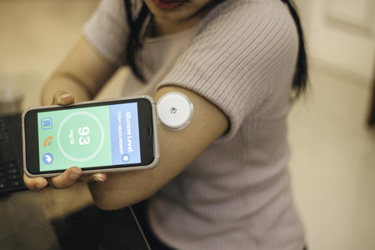Only DTx In Drug Delivery Can Take Us To The Next Level Of Diabetes Care
By Judith Ruiz de Esquide, Insulcloud

Diabetes management has come a long way since the discovery of insulin in 1921, with many revolutionary advances coming to light in the last half-century. However, for much of the time since, the way that patients interact with this lifesaving medication has failed to evolve. Now, with new advancements in drug delivery, the medical community is looking at a new horizon and sees a brighter future for the 38 million Americans, representing nearly 15% of the adult U.S. population,1 currently diagnosed with diabetes.
The convergence of advanced drug delivery technologies, new materials, artificial intelligence, and personalized medicine is reshaping the diabetes landscape of not just insulin pump development but also emerging digital therapeutics and connected devices.
Digital Therapeutics: A Paradigm Shift In Diabetes Management
Digital therapeutics (DTx) deliver a long-awaited revolutionary approach to diabetes management, offering evidence-based therapeutic interventions driven by high-quality software and mobile applications. These promising and accessible solutions aim to prevent, manage, or treat medical disorders or diseases, either as stand-alone applications or applied in tandem with medications, devices, or other therapies.
Glucose measurement has been the gold-standard measurement guiding diabetes management, because for patients who manage their insulin without an automated insulin pump, there is no way to accurately and consistently monitor insulin delivery. While glucose is a key measurement to help patients monitor their diabetes, it is critical that they are also able to monitor insulin levels to slow disease progression. Now, three technological advancements are advancing insulin monitoring into daily care for the vast majority of patients worldwide – and in the U.S.
Smart insulin delivery devices, which entered the U.S. market in late 2017,2 exemplify the potential of DTx in diabetes care. These devices, such as connected insulin pens and caps, automatically track insulin doses, timing, and ambient temperature.3 By integrating this data with continuous glucose monitoring (CGM) information, these systems provide a comprehensive view of diabetes management, enabling more informed decision-making for patients and healthcare providers.
Cloud-based platforms play a crucial role in the DTx ecosystem. These platforms securely store and analyze patient data, facilitating remote monitoring and timely interventions. Healthcare professionals can access the real-time information that enables what both patients and providers crave: more personalized and proactive care.4
But the key to maximizing the benefits of DTx is integration. We must focus on developing interoperable systems that can seamlessly communicate with electronic health records (EHRs), CGMs, insulin pumps, and other relevant devices, while also delivering critical, care-altering information with a patient’s provider in real time. This integration will provide a 360-degree view of the patient's health status and enable more coordinated care.4
Actionable Strategies For Implementation
To successfully implement DTx solutions in diabetes management, our industry and healthcare professionals must adopt a multifaceted approach:
- Enable adoption of technologies: If patients struggle to understand a new technology, they won’t adopt it. We must develop user-friendly interfaces and provide comprehensive training programs for both patients and healthcare providers. It’s also critical to collaborate with payers to ensure adequate reimbursement for DTx solutions.
- Educate patients early: Introduce DTx concepts and benefits during initial diabetes education sessions and ensure resources are easily discoverable online. Emphasize the long-term advantages of adopting these technologies for improved health outcomes.
- Develop personalized treatment plans: Leverage the data collected through DTx to enable AI, informed by clinicians and best-practices, to create tailored management strategies that account for individual patient needs, preferences, and lifestyle factors.
- Implement collaborative care models: Keep physicians in the loop by developing secure, and easy to access, communication channels between patients, primary care providers, and specialists. Encourage regular data review and collaborative decision-making.
- Address health disparities: Develop strategies to ensure equitable access to DTx solutions across diverse populations. This may include partnering with community organizations, offering multilingual support, and creating culturally sensitive educational materials.
- Adapt technology to diverse patient populations: Customize DTx solutions to address the unique needs and experiences of different patient groups, such as those with adult-onset type 2 diabetes versus early-onset type 1 diabetes. This approach ensures broader acceptance and effectiveness across varied life experiences, demographics, and management requirements.
- Tailor solutions for diverse healthcare provider expertise: Design DTx platforms that accommodate the varying levels of clinical skill and technology experience among healthcare providers. This is particularly important for patients with limited access to specialists, enabling primary care physicians to effectively prescribe, titrate, and support diabetes therapy using advanced technologies.
Drug Delivery Providing Peace Of Mind At The Intersection Of Diabetes, Comorbidities, And Drug Interactions
Diabetes often coexists with various comorbidities and secondary diagnoses, including hypertension, cardiac dysfunction,5 dyslipidemia, neurological diseases, diabetic nephropathy, and retinopathy.6 These co-occurring conditions significantly impact patient care and outcomes, necessitating a comprehensive approach to management. Moreover, emerging treatment strategies across diabetes and potential comorbidities have led to a greater need for DTx to help carve a clearer path to health for patients with diabetes.
DTx and connected devices play a crucial role in treating the whole patient by:
- Enhancing medication adherence through smart reminders and automated tracking systems.
- Facilitating early detection of complications through regular screening reminders and data trending analysis.
- Providing personalized recommendations for lifestyle modifications and medication adjustments based on real-time data analysis.
- Integrating multiple health parameters simultaneously, such as blood glucose levels, blood pressure, and lipid profiles to inform treatment decisions.
- Monitoring and managing potential drug interactions, particularly focusing on the dynamic impact of GLP-1 agonists on insulin sensitivity and other medications.
By addressing both diabetes and its comorbidities, we know that DTx solutions can significantly improve overall health outcomes and quality of life for patients while addressing the complex interplay between various medications in diabetes management.
Challenges And Future Directions
Despite the promising potential of DTx in diabetes management, challenges to complete adoption remain:
- Regulatory hurdles: Navigate the evolving regulatory landscape for digital health technologies, working closely with regulators to establish clear guidelines for DTx development and approval.
- Clinical validation: Conduct rigorous clinical trials to demonstrate the safety, efficacy, and economic benefit of DTx solutions in real-world settings.
- Data security and privacy concerns: Implement robust cybersecurity measures to protect sensitive patient information and ensure compliance with regulatory requirements.7
- Integration with existing healthcare systems: Develop standardized protocols for seamless integration of DTx solutions with EHRs and other healthcare IT systems.
- Patient engagement and adherence: Design engaging and motivating user experiences to encourage long-term adherence to DTx interventions.
- A 360-degree view: There is more to diabetes than glucose levels, and patients equipped with a holistic view of their health have the full set of tools they need to partner with their provider to prevent diabetes progression and potential worsening of comorbidities.
Looking ahead, I’m eagerly anticipating several advancements in the field of DTx for diabetes management:
- Advanced artificial intelligence algorithms for predictive analytics and personalized treatment recommendations. These recommendations from near real-time trending and predictive alerts can help patients take the steps they need to proactively guide their own treatment. Even simple recommendations can be highly effective, such as clear recommendations on avoiding intractable hyper hiccups. Simply differentiating between priming and bolus insulin can help patients better manage their treatment and consult their provider before more invasive and expensive reactive treatments are needed.
- Integration of wearable sensors for continuous monitoring of multiple health parameters. Data from connected devices and wearable monitors unlock new dimensions in trending and individualized recommendations to physicians and patients to guide care at a granular level.
- Closed-loop systems that autonomously adjust insulin delivery based on real-time glucose data and other physiological factors.
- Virtual reality and gamification elements to enhance patient education and engagement.
- Expansion of DTx solutions to address pre-diabetes and type 2 diabetes prevention.
Conclusion
The diabetes care devices market is projected to reach $117.7 billion by 2034, growing at a CAGR of 6.2%.8 This growth presents an unprecedented opportunity for innovation in the field of digital therapeutics for diabetes management.
As we advance toward the finish line of optimal diabetes care, it is imperative that the life sciences industry takes bold steps to develop and implement DTx solutions that address both the physical and mental aspects of diabetes management. By embracing these innovations and building upon the strong foundation laid by previous drug delivery breakthroughs, we can create a world where living with diabetes no longer means living in constant worry but, rather, living life to the fullest with the support of powerful, personalized digital tools.
The time for action is now. Let us commit to developing comprehensive DTx solutions and connected devices that not only improve glycemic control but also alleviate the mental burden and cost of diabetes management. By doing so, we can truly help patients, their families and their care teams come closer to achieving peace of mind and finally reach the diabetes care finish line.
References
- Centers for Disease Control and Prevention. National Diabetes Statistics Report. Diabetes. Published May 15, 2024. https://www.cdc.gov/diabetes/php/data-research/index.html
- Masierek M, Nabrdalik K, Janota O, Kwiendacz H, Macherski M, Gumprecht J. The Review of Insulin Pens—Past, Present, and Look to the Future. Frontiers in Endocrinology. 2022;13. doi:https://doi.org/10.3389/fendo.2022.827484
- Galindo RJ, Ramos C, Cardona S, et al. Efficacy of a Smart Insulin Pen Cap for the Management of Patients with Uncontrolled Type 2 Diabetes: A Randomized Cross-Over Trial. J Diabetes Sci Technol. 2023;17(1):201-207. doi:10.1177/19322968211033837
- Gomez-Peralta F, Abreu C, Fernández-Rubio E, et al. Efficacy of a Connected Insulin Pen Cap in People With Noncontrolled Type 1 Diabetes: A Multicenter Randomized Clinical Trial. Diabetes Care. 2023;46(1):206-208. doi:10.2337/dc22-0525
- Sowers JR, Epstein M, Frohlich ED. Diabetes, Hypertension, and Cardiovascular Disease. Hypertension. 2001;37(4):1053-1059. doi:https://doi.org/10.1161/01.hyp.37.4.1053
- Kulkarni A, Thool AR, Daigavane S. Understanding the Clinical Relationship Between Diabetic Retinopathy, Nephropathy, and Neuropathy: A Comprehensive Review. Cur mi eus. Published online March 21, 2024. doi:https://doi.org/10.7759/cureus.56674
- Klonoff AN, Andy) Lee WA, Xu NY, Nguyen KT, DuBord A, Kerr D. Six Digital Health Technologies That Will Transform Diabetes. Journal of Diabetes Science and Technology. 2021;17(1):193229682110434. doi:https://doi.org/10.1177/19322968211043498
- Diabetes Care Devices Market. www.futuremarketinsights.com. https://www.futuremarketinsights.com/reports/diabetes-care-devices-market
About The Author:
 Judith Ruiz de Esquide is the general manager of Insulcloud, a healthtech company developing solutions for diabetes management. With a multidisciplinary background in law and psychology, and executive education from ESADE Business School, Ruiz de Esquide brings a unique perspective to the intersection of technology and healthcare. Her expertise spans regulatory pathways for medical devices, user-centered design in healthcare applications, and the impact of connected devices on patient outcomes. Fluent in four languages and with international work experience spanning six countries, Ruiz de Esquide offers a global perspective in advancing drug delivery technology.
Judith Ruiz de Esquide is the general manager of Insulcloud, a healthtech company developing solutions for diabetes management. With a multidisciplinary background in law and psychology, and executive education from ESADE Business School, Ruiz de Esquide brings a unique perspective to the intersection of technology and healthcare. Her expertise spans regulatory pathways for medical devices, user-centered design in healthcare applications, and the impact of connected devices on patient outcomes. Fluent in four languages and with international work experience spanning six countries, Ruiz de Esquide offers a global perspective in advancing drug delivery technology.
